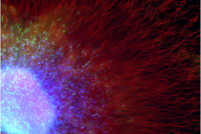Our research in tissue repair is focused on engineering biomaterials that can harness natural cellular and molecular healing pathways to enhance functional in situ tissue regeneration, without the use of exogenous cell therapy. Although the healing process that leads to functional regeneration relies on numerous biological events, it can often be catalyzed and sustained by a single inductive factor. Our approach employs natural proteins and their degradation products to facilitate induction of tissue repair.
Cartilage and bone repair
In osteochondral tissue regeneration, the regulation of cellular morphogenesis and differentiation via the provisional extracellular matrix (ECM) is one of the hallmarks of a successful repair process. Our group has been working towards developing hydrogel biomaterials the mimic the inductive repair characteristics of the natural provision ECM, fibrin, using protein-polymer chemistry. We apply our semi-synthetic protein-polymer hydrogels as a provisional ECM-analog for the repair of various focal defects, including in cartilage and bone injuries. The dense hydrogels, which displace the blood clot in the injury, are designed with a resorption rate that is synchronized with the natural repair process. Immobilized growth factors, such as bone morphogenic protein (BMP), can also be used to accelerate the tissue repair process. As the implant degrades, the liberation of bioactive factors in a sustained manner can recruit progenitor stem cells to the injury site, guide the differentiation of these progenitors into mature specialized cells, and dramatically improve the efficacy of clinical therapies aimed at restoring the damaged tissues.
Nerve regeneration
To overcome a limited regenerative capacity of peripheral nerve injuries, engineering strategies have aimed to produce nerve guidance conduits (NGCs) that can promote nerve regeneration. Our research explores the use of semi-synthetic hydrogels as NGCs that provide precisely controlled environmental stimuli to activate neuronal and glial cell repair. The nerve conduits that we develop are comprised of proteins, including fibrinogen, gelatin, or albumin, which were conjugated to a synthetic polymer, PEG. By changing the relative amounts of protein and PEG, we achieve the desired protein composition, mechanical properties, degradation rate, and structural features of the NGC matrix. Our ongoing work demonstrates the capability of the PEG-Fib, PEG-Gel, and PEG-Alb hydrogels in supporting neurite and Schwann cell invasion from encapsulated DRGs using an in vitro assay. Altering the matrix properties results in different invasion kinetics of the DRG cells into the various hydrogel compositions. Creating laser-ablated microchannels in these hydrogels further attained accelerated directional outgrowth of neuritis. We use the PEG-Fib hydrogels, with or without microchannels, to accelerate in vivo nerve regeneration in an 8-mm rat sciatic nerve resection model. Using these approaches, we continue to explore the utility of a semi-synthetic NGC material in providing a means to better control and enhance natural repair processes of injured peripheral nerves.
Relevant Publications
No publications found.
